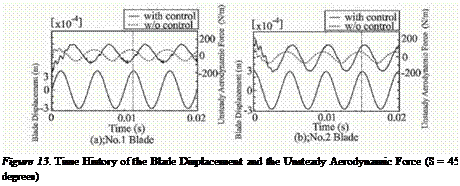Analysis in the case when all blades are forced to oscillate
The phase difference between blade vibration and trailing edge oscillation, denoted as 5, was found to be important in the present analysis. 5 is positive when the phase of trailing edge oscillation advances compared with that of the blade vibration. Eight cases of 5, 5 = -135, -90, -45, 0, 45, 90, 135, 180 (deg.), were analyzed in the study, and two characteristic results of 5 = 45 and 5 = -135 (deg.) cases are reported here.
For the feasibility study of the method, the case in which all blades were forced to oscillate with 90 degrees of inter blade phase angle were analyzed first. The trailing edges of No.1 and No.3 blades were oscillated and those of No.2 and No.4 blades were not oscillated.
Figure 13 shows the time history of the displacement and the unsteady aerodynamic force of the No.1 and No.2 blades when 5 = 45 (deg.). In Fig.13, dot-
|
|

 ted line indicates the results of the case without control (trailing edges of the blades are not oscillated). In the controlled case, the blade with trailing edge oscillation (in this case, No.1 and No.3 blades) is called "controlled blade”, while the blade without trailing edge oscillation (No.2 and No.4 blades) is called "non-controlled blade." In the results of the case without control (dotted line) shown in Fig.13, the phase of the unsteady aerodynamic force advanced compared with that of the blade displacement. In this situation, the unsteady aerodynamic force acts on blade as an exciting force, so that the blade vibration is unstable. On the other hand, in the case with trailing edge oscillation (5 = 45 deg.), the phase of the unsteady aerodynamic force delays compared with that of blade displacement on both controlled and non-controlled blades. In this situation, the unsteady aerodynamic force acts on the blade as a damping force. From the result, it is found that the trailing edge oscillation can change the unsteady aerodynamic force from exciting to damping force when 5 is 45 degrees.
ted line indicates the results of the case without control (trailing edges of the blades are not oscillated). In the controlled case, the blade with trailing edge oscillation (in this case, No.1 and No.3 blades) is called "controlled blade”, while the blade without trailing edge oscillation (No.2 and No.4 blades) is called "non-controlled blade." In the results of the case without control (dotted line) shown in Fig.13, the phase of the unsteady aerodynamic force advanced compared with that of the blade displacement. In this situation, the unsteady aerodynamic force acts on blade as an exciting force, so that the blade vibration is unstable. On the other hand, in the case with trailing edge oscillation (5 = 45 deg.), the phase of the unsteady aerodynamic force delays compared with that of blade displacement on both controlled and non-controlled blades. In this situation, the unsteady aerodynamic force acts on the blade as a damping force. From the result, it is found that the trailing edge oscillation can change the unsteady aerodynamic force from exciting to damping force when 5 is 45 degrees.
![]()
![]()
Figure 14 shows the unsteady aerodynamic work distribution on No.1 and No.2 blades when 5 = 45 deg. The peak around 50% chord position on the
|
Figure 15. Unsteady Aerodynamic Work Distribution on Blade Surface (S = -135 degrees) |
pressure surface of controlled blade is seen to become low by trailing edge oscillation. Since the passage shock movement induces this peak, it can be said that the trailing edge oscillation alters the passage shock oscillation. The unsteady aerodynamic work around the fhpping oscillation region is different from that of the case without trailing edge oscillation, which is also caused by the trailing edge oscillation. Through the integration of the chordwise distribution of unsteady aerodynamic work shown in Fig. 14(a), the total value of unsteady aerodynamic work was found to shift from positive one to negative one. From Fig. 14(b), the results of non-controlled blade, the positive peak around 50% chord in the pressure surface changes to negative one.
Figure 15 shows the unsteady aerodynamic work distribution on No.1 and No.2 blades when 5 = -135 degrees. The peak level around 50% chord in the pressure surface of controlled blade was same as that in the case without control. On the other hand, the unsteady aerodynamic work on the fhpping oscillation region was increased by this control. In the results of non-controlled blade as shown in Fig. 15(b), the unsteady aerodynamic work induced by passage shock movement is observed to increase in the case with control. When 5 = -135 degrees, therefore, the trailing edge oscillation increases the exciting force on the blades compared with that in the case without control.
In the present control method with trailing edge oscillation, the phase difference 5 is a quite infhential factor for instability. The proper selection of 5 is very important.













